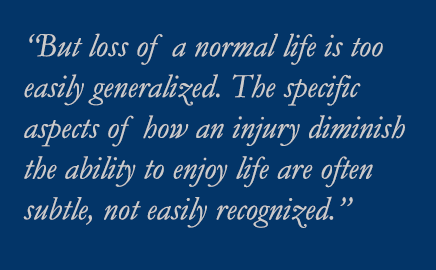 Under Illinois law, disability is characterized as a “loss of a normal life.” The Illinois Pattern Jury Instruction, 30.04.02, defines this element of damage as follows: “When I use the expression “loss of a normal life”, I mean the temporary or permanent diminished ability to enjoy life. This includes a person’s inability to pursue the pleasurable aspects of life.”
Under Illinois law, disability is characterized as a “loss of a normal life.” The Illinois Pattern Jury Instruction, 30.04.02, defines this element of damage as follows: “When I use the expression “loss of a normal life”, I mean the temporary or permanent diminished ability to enjoy life. This includes a person’s inability to pursue the pleasurable aspects of life.”
Diminished ability to enjoy life. This is a broad category encompassing the largest and smallest aspects of everyday life. Washing a window. Painting a canvas. Gripping a set of utensils. Using both hands on a keyboard. Standing on a ladder. Carrying an item. Holding a baby. It seems clear that even the simplest of tasks require some degree of coordination between mind and body. When the body has been injured this ability is reduced.
But loss of a normal life is too easily generalized. The specific aspects of how an injury diminish the ability to enjoy life are often subtle, not easily recognized. Fine movements that require a high degree of manual dexterity—say, picking up and holding a small object—are often the last, if at all, to be regained. Smaller movements impact the ability to carry out larger tasks as well. Think of dialing the combination on a padlock or pressing the numbers on a cell phone—a slight infirmity, particularly if lasting and painful, can give rise to significant incapacity.
Injuries to one part of the body can affect another. The sartorius muscle, the longest muscle in the body, attaches at the iliac spine and extends as far as the medial aspect of the knee. The phrenic nerve originates at the neck (C3-C5) and continues between the lung and heart to reach the diaphragm. The median nerve, a branch of the medial and lateral cords of the brachial plexus, provides sensation to the thumb, 1st, 2nd, 3rd and half of the 4th finger. Injury to any one of these areas can have a pronounced effect upon another.
Inability to pursue the pleasurable aspects of life. The pleasurable aspects of life would include eating and sleeping, exercising and working. Something as simple as caring for one’s children or spending time with one’s friends and family would be included as well. Webster defines pleasure as “a feeling of happiness, enjoyment, or satisfaction : a pleasant or pleasing feeling.” Small pleasures play a significant role in defining the texture of a life. A cup of coffee in the morning will not be quite the same if the cup cannot be securely grasped and raised easily to drink.
Someone someday should write a “Phenomenology of Injury,” combining the fields of human physiology, biomechanics, anatomy, medicine, psychology, and consciousness. Probably any number of new insights would be revealed. Perhaps one of the conclusions that might be drawn would be the interconnectedness between seemingly unrelated organ systems. Perhaps another would be the realization that any injury—no matter how large or small—significantly affects living and quality of life in ways not yet recognized.




